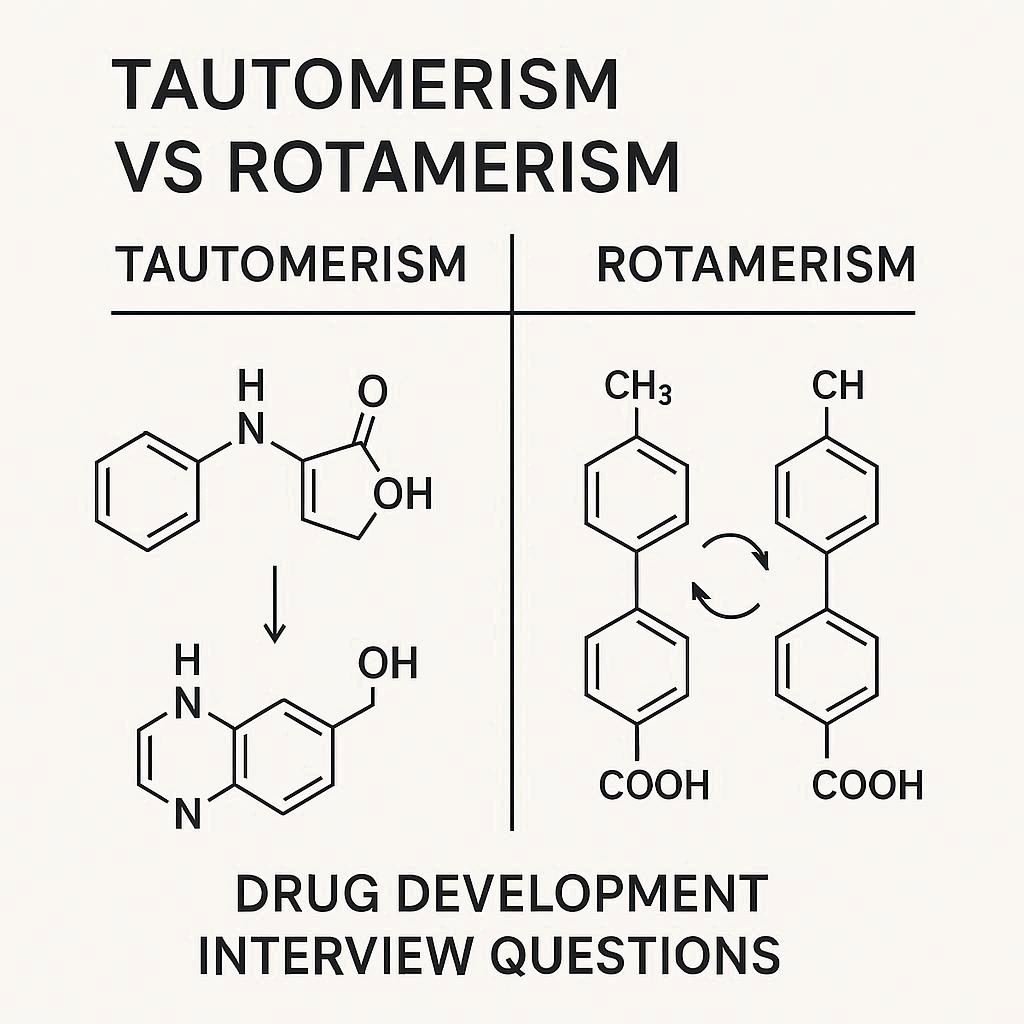
Tautomerism in pharmaceuticals refers to the interconversion of structural isomers via the migration of a hydrogen atom, while rotamerism involves the interconversion of conformational isomers through rotation around a single bond. Both processes can profoundly influence a drug’s stability, bioavailability, and pharmacological activity, with tautomeric transitions typically requiring a higher energy barrier than rotameric changes. […]
Tautomerism in pharmaceuticals refers to the interconversion of structural isomers via the migration of a hydrogen atom, while rotamerism involves the interconversion of conformational isomers through rotation around a single bond. Both processes can profoundly influence a drug’s stability, bioavailability, and pharmacological activity, with tautomeric transitions typically requiring a higher energy barrier than rotameric changes.
| Aspect | Tautomerism | Rotamerism |
|---|---|---|
| Definition | Interconversion between structural isomers via the migration of a hydrogen atom and a double bond. | Interconversion between conformational isomers through rotation around single bonds. |
| Mechanism | Involves proton migration and shift in double bonds. | Involves rotation around single bonds, no bond breaking or forming. |
| Energy Barrier | Generally higher due to the need to break and form bonds. | Lower energy barrier as it only involves bond rotation. |
| Impact on Drug Properties | Affects molecular flexibility and protein binding, but is typically less impactful on activity. | Significantly, as different tautomers may interact differently with the target (e.g., enzymes, receptors). |
| Stability and Bioavailability | Tautomeric forms can alter stability, solubility, and bioavailability depending on the tautomer’s properties. | Rotamers generally do not have a major effect on stability or bioavailability. |
| Relevance in Drug Design | Important for optimising the desired tautomer for bioactivity and minimising unwanted forms. | Important for molecular flexibility and receptor interaction but usually secondary in importance. |
| Examples | Keto-enol tautomerism (e.g., acetylacetone). | Cis-trans isomerism or different rotamers of a flexible molecule. |
| Effect on Pharmacodynamics | It may exist as an equilibrium of tautomers, potentially affecting compound stability. | Limited, but rotameric changes can affect binding or molecular shape at the target site. |
| Stability in Solution | May exist as an equilibrium of tautomers, potentially affecting compound stability. | Rotamers exist in dynamic equilibrium with each other, typically not affecting solution stability significantly. |
| Key Challenge in Drug Development | Balancing tautomeric forms to ensure the desired one is predominant, affecting drug design and formulation. | Ensuring the correct rotamer is adopted for efficient binding and function, though this is generally less challenging than tautomerism. |
You May Like
Tautomerism can affect a drug’s stability, solubility, binding affinity, and bioavailability, influencing both efficacy and safety profiles during drug discovery and development.
Yes, because different tautomers of a drug may have different biological activities, receptor affinities, and physicochemical properties.
Tautomers can bind differently to biological targets, potentially altering the drug’s pharmacodynamics and therapeutic effect.
Yes, tautomerism can impact absorption, distribution, metabolism, and excretion (ADME) by affecting solubility, permeability, and metabolic pathways.
Tautomers are structural isomers that differ in proton position and bonding patterns, while rotamers are conformational isomers differing by rotation around single bonds without bond rearrangement.
Rotamers influence molecular flexibility and shape, which can affect how a drug fits into and interacts with its biological target (e.g., receptor or enzyme binding).
Both pH and temperature can shift the tautomeric equilibrium, favoring one form over another, which may affect a drug’s stability and activity.
Common examples include:
Rotamers exist due to free rotation around single bonds, allowing multiple energetically accessible conformations of a molecule.
Rotamers are based on the different spatial arrangements of atoms resulting from rotation around a single sigma bond.
No, rotamers are conformers, not true isomers—they have the same molecular formula and connectivity but differ in 3D arrangement.
No, Enalapril Maleate does not exhibit tautomerism under normal conditions.
Does Pioglitazone show tautomerism?
Yes, Pioglitazone may exhibit tautomerism due to its thiazolidinedione ring, which can undergo proton shifts under certain conditions.

Enalapril Maleate contains several single bonds, particularly around the amide group (–CO–NH–), which allows rotation. Rotation around the C–N bond in amides can lead to different rotamers (cis and trans forms), especially when influenced by intramolecular interactions or steric hindrance.
So, while rotamerism in Enalapril Maleate may not be biologically critical, it does exist and can be relevant in pharmaceutical analysis and solid-state characterisation.
Quick Links